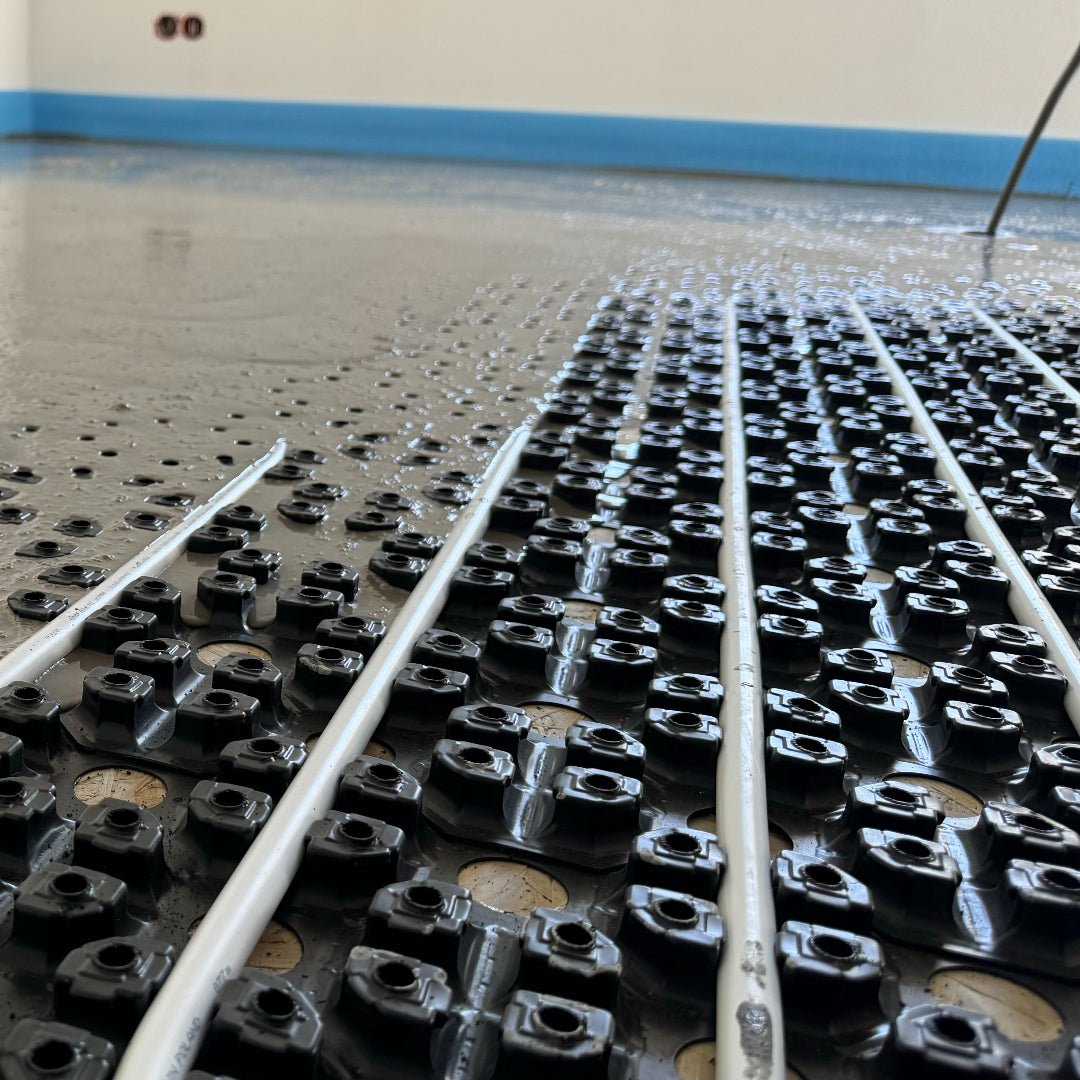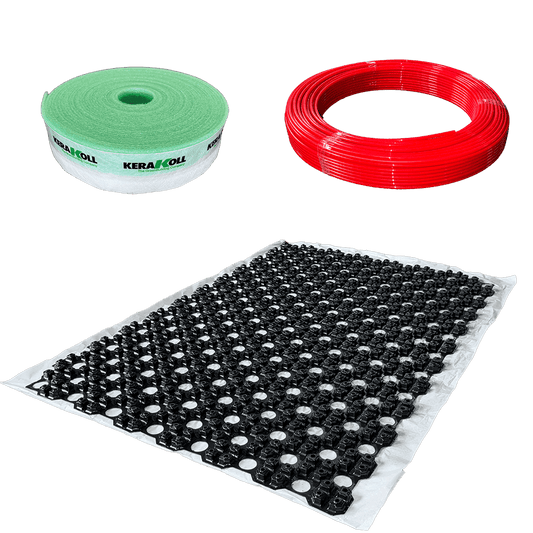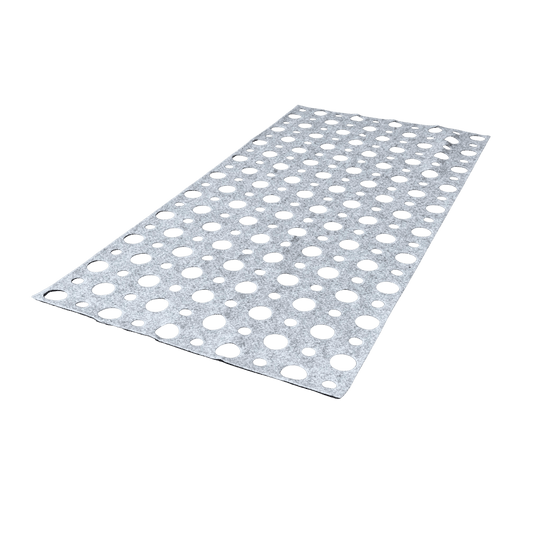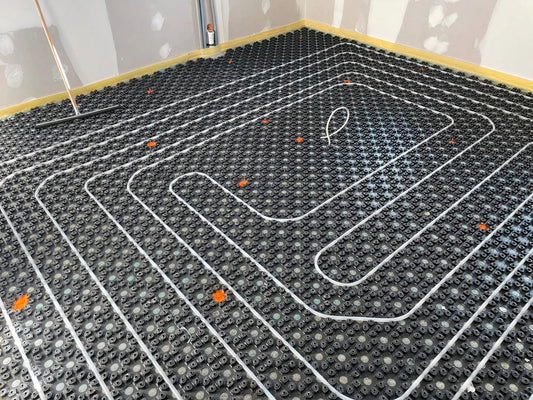
Installation instructions: MC Therm thin-bed underfloor heating with dimpled foil 🔧 🔥
Georg CholewaShare
NerthusFlow (thin-bed underfloor heating) from MC Therm is the ideal solution for renovations and modernizations. Thanks to its low installation height, this system is ideal for retrofitting. This step-by-step guide will show you how to correctly install the thin-bed underfloor heating with dimpled foil . 🚀♨️
Table of contents
- 1. ✨Advantages of NerthusFlow underfloor heating thin-bed dimpled film
- 2. Step 1: Preparation of the substrate
- 3. Step 2: Laying edge insulation strips
- 4. Step 3: Laying the thin-bed dimpled film
- 5. Step 4: Laying the underfloor heating pipes
- 6. Step 5: System pressure test and screed application
- 7.
✅ Conclusion: MC Therm thin-bed underfloor heating 🔥
✨Advantages of NerthusFlow underfloor heating thin-bed dimpled film
- Low installation height of only 18mm including screed
- Quick installation thanks to self-adhesive bubble wrap
- Efficient heat distribution with fast response times
- Easy integration into existing heating systems
- Underfloor heating renovation & refurbishment made easy
- Low static weight due to low screed mass
- Installation on various floor coverings
Step 1: Preparing the surface
Before you begin installation, ensure the subfloor is sound, clean, and properly primed. A stable and level subfloor ensures optimal adhesion of the dimpled film. If necessary, remove old radiators and prepare the connections for the system.
Step 2: Laying edge insulation strips
The first step is installing the edge insulation strip. For this, we recommend the reinforced Kerakoll edge insulation strip , which is 5 cm high. This provides sound insulation, prevents tension in the screed, and, unlike traditional edge insulation strips, minimizes the flow of the leveling compound. However, holes, etc., must be sealed with foam sealants. We also recommend applying a thin foam sealant around the entire edge—this prevents the flowing screed from peeling off and saves unnecessary extra costs.
- Lay out the edge insulation strip all the way around the room.
- The self-adhesive base is fixed to the surface.
- Additional fastening to the wall is not necessary.
- Close all holes to prevent the screed from draining away.
Step 3: Laying the thin-bed dimpled film
Once the edge insulation strip is installed, start laying the MC Therm thin-bed dimpled film:
- Start in a corner of the room and place the first panel so that the corner studs are exactly in the corner.
- Make sure that you do not place the board on the web, but on the web of the edge insulation strip.
- Remove the protective film from the adhesive surface and press the plate firmly onto the surface.
- The panels are connected via the integrated snap fastener, which makes installation particularly easy.
- If necessary, the mats can be individually cut to size with a cutter knife, for example at the edges or in the area of the heating circuit manifold.
The NerthusFlow bubble wrap is available in 3 versions for different pipe circumferences and installation heights:
| Unit | NerthusFlow NP 12 | NerthusFlow NP 14 | NerthusFlow NP 16 | |
| Article number | - | 50-020-012 | 50-020-014 | 50-020-016 |
| Plate size | mm | 1120x760 | 1120x760 | 1097x790 |
| Plate thickness | mm | 13 | 15 | 17 |
| Pipe diameter | mm | 12 | 14 | 16 |
| Weight | kg per piece | 0.7 | 0.7 | 0.7 |
Step 4: Laying the underfloor heating pipes

Now the area is ready for pipe laying:
- Cut the heating pipe straight with pipe shears.
- First slide the union nut and the clamping ring over the pipe.
- Insert the support body into the pipe until it stops.
- Screw the union nut onto the distributor connection without tilting it.
Now you start with the actual pipe laying:
- The heating pipe is usually laid in a spiral shape from the outside to the inside.
- The distance between dimpled sheets is 5 cm, so the system works with a 10 cm installation grid.
- Use a pipe reel to unwind the pipe neatly without twisting it.
- Once you reach the center of the spiral, turn the pipe and guide it back to the heating circuit manifold between the previously installed tracks. Connect the end piece to the heating circuit manifold.
- Make a note of the individual heating circuits and their positions to enable easy assignment later.
- For pipes with a diameter of 10 or 12 mm, we recommend a maximum heating circuit length of 70 m. Please consult a specialist before installation.
Step 5: System pressure test and screed application
- Before laying the screed, the system should be checked for leaks.
- The thin-layer screed or a suitable leveling compound can then be applied. Our proven choice is Planogel Rheo from Kerakoll , which allows for a pipe coverage of 5 mm and guarantees short reaction times. Please check the product's specific characteristics before pouring the screed.
- We recommend using a mixing pump when pouring the screed.
- After pouring, the screed must be ventilated and smoothed accordingly.
- The screed should always be poured by a professional!

💡Note: The leveling compound can be applied to almost any substrate. Do not use outdoors, on highly flexible substrates, on substrates subject to thermal expansion, on wet substrates, on substrates exposed to constant rising moisture, or for floating or decoupled installation. It is not suitable for rooms with constant water exposure. MC Therm Nerthus Flow (thin-bed underfloor heating) is now successfully installed and, once the system has cured, is ready for the flooring installer to repair any unevenness. Pay attention to the drying times of the leveling compound and install the flooring as soon as possible after it has dried.
MC Therm Nerthus Flow (thin-bed underfloor heating) has now been successfully installed and, once the system has cured, is ready for the flooring installer, who may need to repair any unevenness. Pay attention to the drying times of the leveling compound and install the flooring shortly after it dries.
✅ Conclusion: MC Therm thin-bed underfloor heating 🔥
MC Therm's thin-bed underfloor heating system enables quick and efficient installation thanks to its low installation height and innovative technology. The self-adhesive dimpled foil and practical snap fasteners make installation particularly easy and secure. With these instructions, you can professionally install your new underfloor heating and benefit from even and comfortable heat distribution.
Important: We recommend involving experts to assess the structural design, insulation, and subfloor, as well as to optimally coordinate the system selection. Furthermore, installation should be carried out by a qualified heating engineer.
🛠️✨ Start laying now and enjoy maximum living comfort! 🏠🔥








